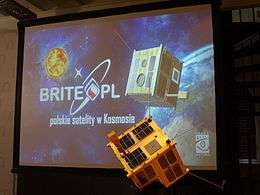Heweliusz (satellite)
 A replica of Heweliusz | |
| Mission type | Astronomy |
|---|---|
| Operator | Space Research Centre |
| COSPAR ID | 2014-049B |
| Spacecraft properties | |
| Bus | GNB |
| Manufacturer | Space Research Centre |
| Launch mass | 7 kilograms (15 lb) |
| Start of mission | |
| Launch date | 19 August 2014, 03:15 UTC |
| Rocket | Chang Zheng 4B |
| Launch site | Taiyuan 9 |
| Contractor | China Great Wall Industry Corporation |
| Orbital parameters | |
| Reference system | Geocentric |
| Regime | Low Earth |
Heweliusz is the second[1] Polish scientific satellite launched in 2014 as part of the Bright-star Target Explorer (BRITE) programme. The spacecraft was launched aboard a Chang Zheng 4B rocket in August 2014. Heweliusz is an optical astronomy spacecraft operated by the Space Research Centre of the Polish Academy of Sciences; it is one of two Polish contributions to the BRITE constellation along with the Lem satellite. It is named after Johannes Hevelius.
Features
Heweliusz is the third[2] Polish satellite (after PW-Sat and Lem) ever launched. Along with Lem, TUGSAT-1, UniBRITE-1 and BRITE-Toronto, it is one from a constellation of six nanosatellites of the BRIght-star Target Explorer project, operated by a consortium of universities from Canada, Austria and Poland.[3]
Heweliusz was developed and manufactured by the Space Research Centre of the Polish Academy of Sciences between 2010 and 2012, based around the Generic Nanosatellite Bus, and had a mass at launch of 7 kilograms (15 lb) (plus another 7 kg for the XPOD separation system).[4] The satellite is used, along with four other operating spacecraft,[lower-alpha 1], to conduct photometric observations of stars with an apparent magnitude of greater than 4.0 as seen from Earth.[6] Heweliusz was one of two Polish BRITE satellites launched, along with the Lem spacecraft. Four more satellites—two Austrian and two Canadian—were launched at different dates.
Heweliusz will observe the stars in the red color range whereas Lem will do it in blue. Due to the multicolour option, geometrical and thermal effects in the analysis of the observed phenomena are separated. Both of the much larger satellites, such as MOST and CoRoT, do not have this colour option; this will be crucial in the diagnosis of the internal structure of stars.[7] Heweliusz will photometrically measure low-level oscillations and temperature variations in stars brighter than visual magnitude (4.0), with unprecedented precision and temporal coverage not achievable through terrestrial based methods.[4]
Launch
The Heweliusz satellite along with Chinese Gaofen satellite was launched through the BRITE-PL Project satellite launch programme established in 2009 by The Space Research Centre of the Polish Academy of Sciences and The Nicolaus Copernicus Astronomical Centre of the Polish Academy of Sciences in cooperation with University of Toronto.[8] The launch was subcontracted to the China Great Wall Industry Corporation and China Aerospace Science and Technology Corporation (CASC) which launched the satellites using Long March 4B rocket from the Taiyuan Satellite Launch Center.[9] The launch took place at 03:15 UTC on 19 August 2014, and the rocket deployed all of its payloads successfully.[10]
See also
Explanatory notes
- ↑ The sixth satellite, BRITE-Montreal, is possibly lost.[5]
References
- ↑ "Polish scientific satellite Hevelius will be launched on July 10". First Polish Political Satellite. PAP; naukawpolsce.pap.pl. 20 June 2014. Retrieved 14 November 2014.
- ↑ "Live event – BRITE-PL 2 Heweliusz launch". http://www.kosmonauta.net/. 18 August 2014. Retrieved 14 November 2014. External link in
|publisher=(help) - ↑ "Science". First Polish Political Satellite. Space Research Centre; Nicolaus Copernicus Astronomical Center. 27 August 2014. Archived from the original on 17 October 2014. Retrieved 26 August 2014.
- 1 2 "PSLV-C20/SARAL Mission" (PDF). Indian Space Research Organisation. 25 February 2013. Archived from the original (PDF) on 6 October 2014. Retrieved 26 August 2014.
- ↑ Semeniuk, Ivan (3 July 2014). "Canadian astronomy satellite lost as another looks for rescue". The Globe and Mail. Archived from the original on 2 September 2014. Retrieved 26 August 2014.
- ↑ "Science Goals". BRITE–Constellation. University of Vienna. 17 January 2011. Archived from the original on 19 October 2013. Retrieved 26 August 2014.
- ↑ "Universität Wien startet ins All" [University of Vienna launches into space] (in German). University of Vienna. 20 February 2013. Archived from the original on 26 August 2014. Retrieved 26 August 2014.
- ↑ Krebs, Gunter (8 November 2013). "BRITE-PL, PL2 (CanX 3C, 3D / Lem, Heweliusz)". Gunter's Space Page. Archived from the original on 7 October 2014. Retrieved 28 August 2014.
- ↑ "(untitled)". First Polish Political Satellite. Space Research Centre; Nicolaus Copernicus Astronomical Center. Archived from the original on 8 October 2014. Retrieved 28 August 2014.
- ↑ Clark, Stephen (20 August 2014). "Chinese, Polish satellites launched by Long March". Spaceflight Now. Archived from the original on 13 November 2014. Retrieved 26 August 2014.
| ||||||||||||||||||||||||||||||||||||||||||||||||||||||
| ||||||